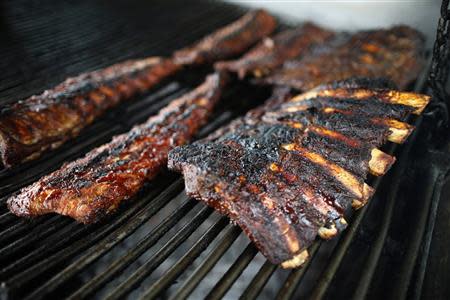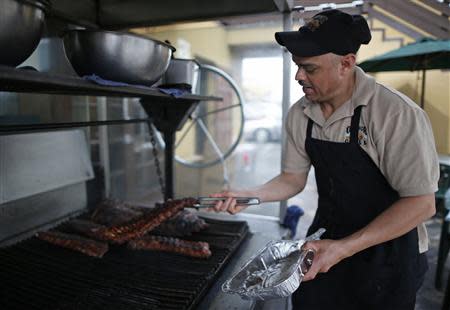U.S. barbecues grow pricier as beef, pork reach record highs
By Lisa Baertlein and P.J. Huffstutter (Reuters) - With the Chicago weather finally getting a little nicer, Chris Anderssen wanted to grill some burgers outside for a group of family and friends. When she got to the meat aisle at her local Jewel-Osco supermarket, a case of sticker shock made her change the menu: extra lean ground beef was $4.99 a pound. "Five adults, four teenagers, that's a lot of hamburger to buy," said Anderssen, a 42-year-old mother of two who works as an office manager. She bought chicken instead for $2.99 a pound. Retail beef and pork prices reached all-time highs last month, according to Bill Hahn, agricultural economist at the U.S. Department of Agriculture's Economic Research Service. That's prompting some consumers to pivot to less expensive protein sources and driving the grocery, packaged food and restaurant industries to adjust portion sizes, tweak their menus and roll out new products in a bid to address higher food costs without driving customers away. Beef prices are higher because of rising feed costs and the decline of the U.S. domestic cattle herd, now the smallest since 1951. Pork prices have been rising in part because of a deadly piglet virus that began in Ohio last year and whose causes are still unknown. Prices for beef and poultry destined for home consumption are forecast to rise as much as 4 percent in 2014, while pork prices may gain 3 percent, according to the USDA. The retail price for beef was $5.72 a pound in March, passing the previous record of $5.58 in February. A year ago the beef price was $5.26. Pork retailed for $3.83 a pound in March, beating the former record high of $3.81 set last October. A year ago, pork was selling for $3.52, the USDA said. Higher prices are benefiting producers including Tyson Foods Inc, the largest U.S. meat processor, which said on January 31 that higher prices for beef and robust demand for chicken boosted its profits Still, many consumers are sticking with meat. Soaring prices "might dent the consumption a little bit, but right now the reason prices are high is because demand is good and supplies are low," Credit Suisse's New York-based food analyst Robert Moskow said. An improving U.S. economy is helping consumers stick with their favorite foods, said Wolfe Research retail analyst Scott Mushkin, also based in New York. "People grumble about the price of bacon but still eat bacon," Mushkin said. Edwin Laboy, known among his friends and family in West Palm Beach, Florida, for dishes ranging from pork spare ribs to whole roasted pigs, is among those unwilling to give up his favorite foods. "I accept it," the 36-year-old utility company supervisor said. "I don't like it." Laboy said he and his brother decided to team up to buy the hog they roasted for a recent holiday celebration. Food retailers are responding to higher prices by offering more small-sized fresh meat portions, said Phil Lempert, who's known as the "Supermarket guru" and writes the Lempert Report, a trade publication on grocery stories. "People are buying smarter," said Lempert, adding that some home cooks are stretching their food dollars by blending ground beef with vegetables and other ingredients in dishes like lasagna. Demand for protein is also growing as consumers shift away from waistband-expanding foods featuring carbohydrates such as processed grains and added sugar. Consumption of processed protein foods such as sausage, breakfast sandwiches, Greek yogurt and protein bars has grown 7 percent since 2009, according to Moskow. During that same period, consumption of foods made from processed carbohydrates, including snacks such as chips and crackers, have fallen 5 percent, said Moskow, who recently published a note titled "Return of the Caveman." Packaged food sellers including Hillshire Brands Co, Hormel Foods Corp and Kraft Foods Group Inc have begun marketing new protein snacks. Kraft's "P3" snacks include small portions of cheese, nuts and meat in a package resembling the company's own Lunchables meal packs for kids, for which consumers are willing to pay higher prices because of their convenience. Raising prices for more utilitarian packaged meats, however, has proven tricky. Hillshire lost "fairly significant short-term market share" after boosting prices on sausages and hot dogs in December, months before rivals began following its lead, Moskow said. Reluctant to take a similar risk, most traditional packaged food makers are scouring their businesses for cost savings to offset higher meat prices and lackluster demand for processed food. RESTAURANT OPERATORS U.S. restaurant operators, many of whom are swallowing higher meat prices to avoid the risk of a consumer backlash, are switching to smaller as well as lower-quality cuts. Bloomin' Brands Inc's Outback Steakhouse and Darden Restaurants Inc's LongHorn Steakhouse have promoted smaller "petite" steaks as well as seafood and chicken dinners, said ITG Investment Research restaurant analyst Steve West in St. Louis. With chicken prices rising, the switch to poultry saves restaurants only so much, so some are heavily breading meat to add bulk while keeping menu prices in check, said Bob Goldin, an executive vice president at consulting firm Technomic in Chicago. Buffalo Wild Wings Inc last summer started selling its namesake chicken wings by weight instead of by the piece. The pieces are never uniform in size, so the move should help the chain more effectively manage their cost, West said. Higher prices for steak, avocados and cheese convinced Chipotle Mexican Grill, the popular burrito chain, that it couldn't delay raising prices any longer. "It's been nearly three years since our last company-wide price increase, and while we want to remain accessible to our customers, we are at a point where we have to pass along these rapidly rising food costs," said Jack Hartung, Chipotle's chief financial officer, on a conference call with analysts on Thursday. The moves are designed to help restaurants keep meat price increases in line with those at the supermarket. Meanwhile, restaurants have already lost their grip on customers like Laboy, who doesn't order meat when he dines out. "For the same price of steak at a restaurant, you can buy two to cook at home," said Laboy. Instead, these days, he orders sushi. (Reporting by Lisa Baertlein in Los Angeles and Theopolis Waters in Chicago, Editing by John Pickering)







